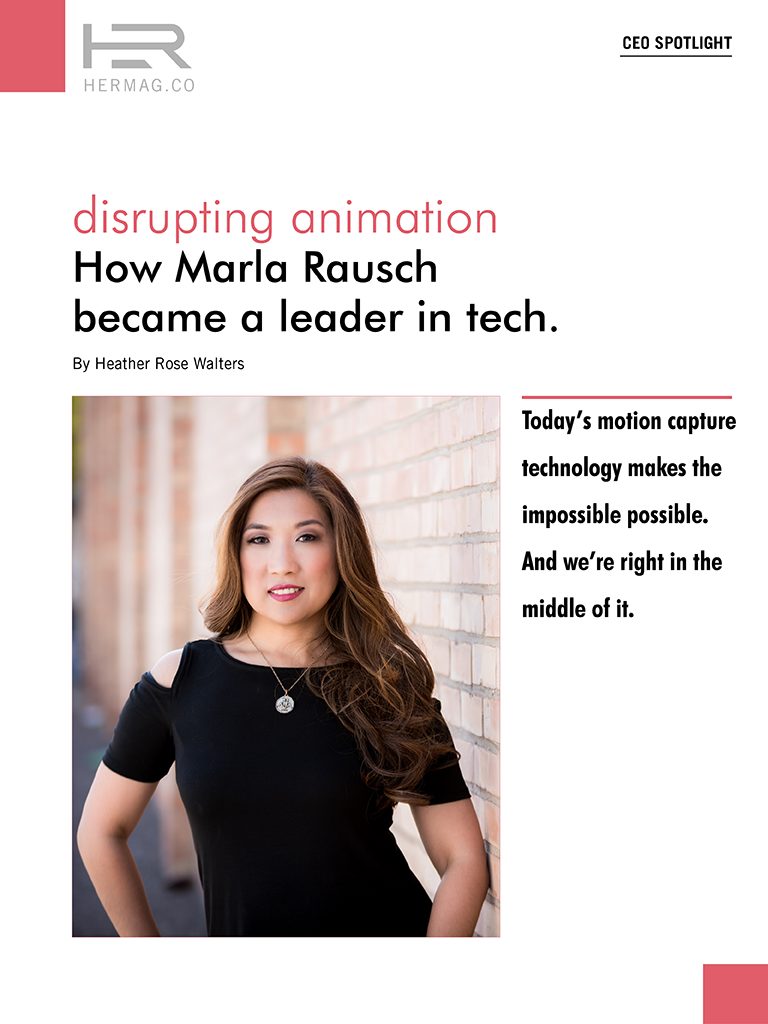“I loved seeing what used to be only possible through our imagination play out in the big screen – the fight scenes especially.”
For Marla Rausch, founder and CEO of Animation Vertigo, motion capture has been a big part of her life since starting her business more than a decade ago. Today, the powerful influence of animation can be seen in movies like Wonder Woman.
“As I watched the action unfold, I was swept into the story of Diana and the Amazons, and knowing that we’re capable of doing that type of work thrills me to no end,” says Rausch.
While motion capture has been around for some time with movies such as Beowolf, Polar Express, and A Christmas Carol, perhaps the Lord of the Rings was the first time motion capture was really extensively talked about. Everyone was in awe of Andy Serkis’ portrayal of Gollum.
Now, motion capture is a part of nearly every major blockbuster — animation and live action weave together so interchangeably, we hardly notice. But Rausch notices its importance; she understands the need to satiate audiences who demand realism attached to a fantasy world they crave, which is why her company is a leader in its field.

THE CATALYST TO HER START IN ANIMATION
“My husband was working in an animation studio in LA. I looked at what he was doing one day and it looked like a puzzle,” says Rausch who reminisces about what first sparked her interest in an industry mostly dominated by men.
At the time, Rausch was a financial advisor, but some days, when her husband’s company would need extra hands on deck, after the market closed, she’d begin her freelance mocap tracking work.
“I was fortunate because the motion capture industry at the time was just coming into its own,” Rausch explains of her foray into this strange, but friendly, new industry.
Juggling a full time job along with her new found passion, Rausch was pregnant when she first gave animation a try, but like any ambitious woman — she dove in head first with an infant already in tow.
“At that time, I had my daughter and a very young son, and I was trying to still be 100% everywhere — which every woman tries to do — I wanted to put 100 percent into everything.”
TAKING A LEAP OF FAITH
“I think what really made me decide to take the leap was the challenge of having your course determined by you alone. Basically, it was up to me to decide how to build the company, how to work and make it succeed – it’s a challenge that I was really curious to see if I could accomplish.”
But even with checks coming in, making that kind of leap from the constancy of a secure job is scary for anybody.
“It was definitely a sit and meditate for a moment thing,” she says.
Marla wanted to be a business woman more than she wanted the comfort a steady paycheck. Using the equity in their house as initial capital, Rausch left her day job to run Animation Vertigo full time.
‘I’ve never thought of myself as an entrepreneur but at that moment, I think I wanted to try. I’m really glad I did.”

A UNIQUE BUSINESS MODEL IS BORN
“What if there was a company that you could get in touch with that had full time employees,” she wondered, “who you could always be sure of the quality, and you don’t have to pay them except when you use them?”
But having a workforce of full-time animators, especially in motion capture, is not always sustainable.
“I was born and raised in the Philippines,” Rausch explains. “I knew there was an untapped talent pool — and there are a lot of people who are passionate about animation in video games or movies, but it was tough to find the opportunities.”
Providing opportunities in her home country and affordable motion capture outsourcing in the film industry, Animation Vertigo was able to meet two needs at once.
They started slow, with three employees, an office manager, a trainer, and Rausch.
“I’m not a huge risk taker,” she admits. “I wanted to make sure that we grew appropriately with the demand of the clients.”
Now, they have upwards of 50 full-time employees.
Success for Animation Vertigo didn’t happen overnight. “Sometimes I felt like it was too slow,” Rausch says, “because now you have more competitors. But I think that by doing it slowly, with emphasis in quality — we formed long term partnerships with clients.”
Rausch’s reputation precedes her in the industry, so those relationships paid off. It was two or three years before the company saw enough profit to start investing in themselves.
A FEMALE LEADER IN A MALE DOMINATED INDUSTRY
“When I first started, I would say, ‘Hi, I work for Animation Vertigo,’ and after talking I realized, wait — he/she thinks I’m just a salesperson.”
During their growth, and even today, Rausch stands out as a female leader of a tech company. Although Rausch says she doesn’t face explicit prejudice, “it’s an unconscious bias.”
Those working in the motion capture field might not have a problem with a woman running a company, they just don’t expect it. Rausch is very aware that this discrimination isn’t intentional.
“It’s been about 14 years; I’ve been fortunate that I’ve never experienced anyone being intentionally discriminatory against me; I find that the men I’ve met in the industry are equally as offended by people who do these things to women.”
ENCOURAGING YOUNG GIRLS TO ENTER TECH
“I think we’re missing out on a whole perspective by not hearing those voices,” she says.
Like many tech fields, there aren’t many women leading the way. Rausch is eager for more to join animation and motion capture; it’s clear she feels the dearth of female voices in her field.
“If we can get more people, more women involved, and more girls encouraged to be part of it for the long term, then I think that would be a great thing.”
It was a woman who inspired Rausch herself to break outside the norm.
“My first mentor was my godmother.”
Her godmother was a former diplomat for the Philippines in Paris. “She was someone I looked up to because she was just so dogged about everything, and so stubborn and willful that she made things happen, because she absolutely believed that she could.”
That was the type of person Rausch always wanted to be; the type of person who could make things happen even when everyone around her told her she couldn’t.
“She’s in her 70’s now and at that time, in that generation, women didn’t have that voice.”
Women might have more of a voice today, but we’ve still got work to do. Thankfully, leaders like Rausch continue to blaze a trail — and make our voices stronger.









